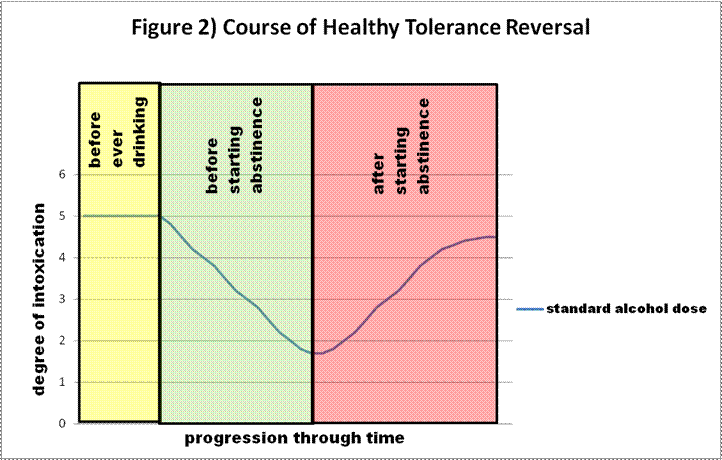Reverse Tolerance occurs when a heavy drinker develops liver damage and the liver no longer produces as great a quantity of the enzymes needed to break down alcohol in the body as it did before. Since people with a lot of alcoholic liver damage can no longer metabolize alcohol very well, these people can get very intoxicated on small quantities of alcohol--much smaller quantities than are needed to affect the person who rarely drinks. This phenomenon is known as Reverse Tolerance. The way that Reverse Tolerance can develop over a lifetime is illustrated by the curve in Figure 1.

As we can see from Figure 1, tolerance in an adult who has never had a drink of alcohol in his/her life remains steady. Once a person begins to drink alcohol on a regular basis the dose response goes down--in other words the same dose of alcohol produces less intoxication than it used to. Saying that the dose response to alcohol goes down is exactly the same as saying that alcohol tolerance goes up--and vice versa. Dose response and tolerance are mirror images of each other. As long as a steady consumption of alcohol is maintained, tolerance will tend to increase and dose response will tend to drop. If liver damage begins to occur, however, tolerance will begin to drop once again and dose response will tend to increase. When there is sufficient damage to the liver there will be considerably less tolerance and considerably greater dose response to alcohol than there was before the person ever took their first drink.
It is important to note that most heavy drinkers do NOT develop liver damage or Reverse Tolerance. The majority of heavy drinkers will not suffer liver damage and hence will not develop Reverse Tolerance.
One should be very careful not to confuse Reverse Tolerance with the Healthy Tolerance Reversal which occurs when a heavy drinker does a period of abstinence from alcohol or a period of moderate drinking. When the amount of alcohol to which the liver is exposed on a daily basis is greatly decreased, liver enzymes begin to return to normal levels and alcohol tolerance (as well as dose response) tends to return to levels similar to those before the subject began drinking heavily.
The essential difference between Reverse Tolerance and Healthy Tolerance Reversal is that Reverse Tolerance is caused by damage to the liver which is often irreversible. In Healthy Tolerance Reversal the liver is actually becoming more healthy than it was during the period of heavy drinking--and the reason why the tolerance is dropping is that the excessive and unhealthy levels of liver enzymes associated with heavy drinking are now returning to normal and healthy levels. In Reverse Tolerance many of the cells needed to produce these enzymes have died and that is the reason why less of the enzymes are produced. In Healthy Tolerance Reversal the liver cells are going back to producing normal levels of these enzymes rather than the excessive levels which they produced during the heavy drinking period--no cells die when Healthy Tolerance Reversal takes place.
A period of abstinence may not necessarily return tolerance to the same levels as before the person ever took a drink of alcohol, however, an abstinence period significantly reduces tolerance from the levels it was at during the time of heavy drinking. Figure 2 illustrates the course of Healthy Tolerance Reversal in a typical individual.

How much time is needed for Healthy Tolerance Reversal to take place? There is not an exact answer to this. Tolerance will start dropping as soon as heavy drinking ceases, but experts say that it takes a month or two for the full effect of Healthy Tolerance Reversal to take place.
For more information about alcohol tolerance please visit our web page What Is Alcohol Tolerance?



